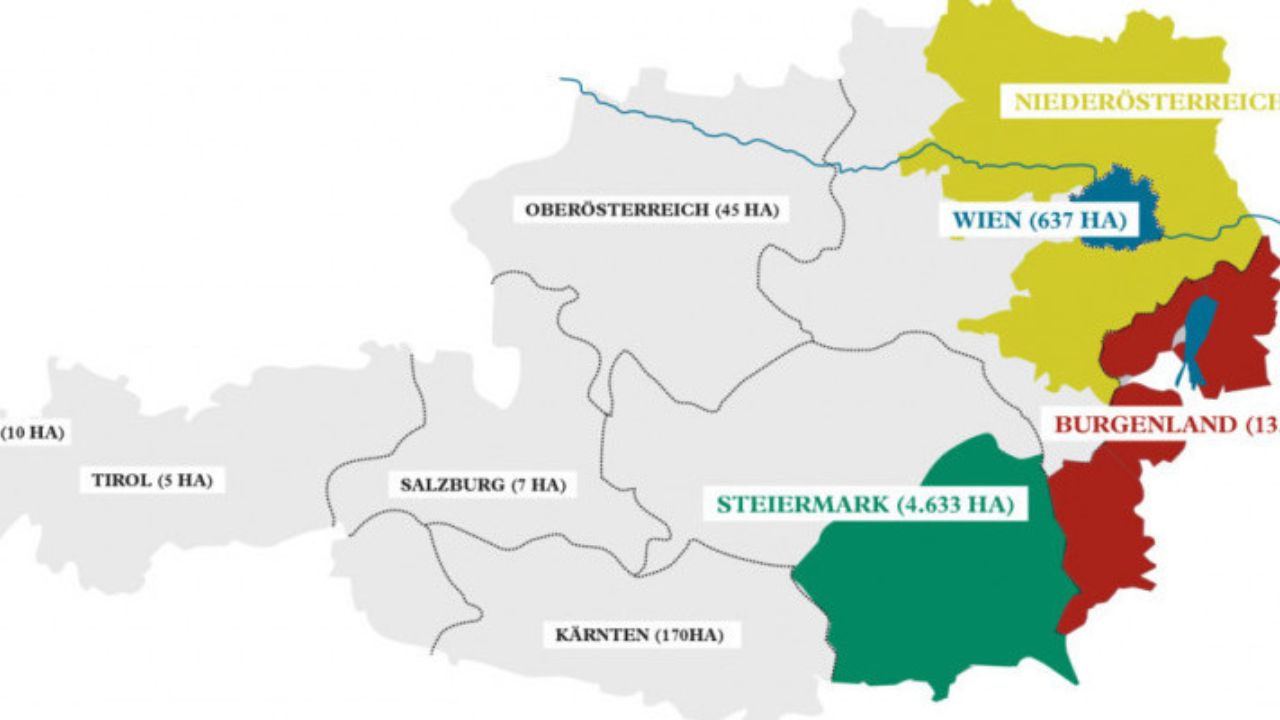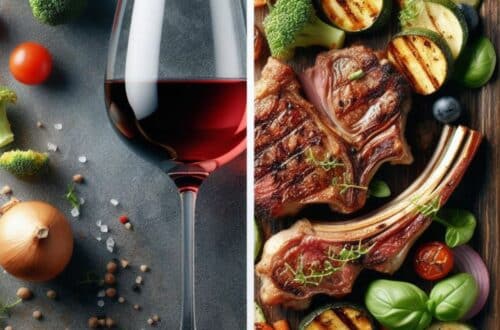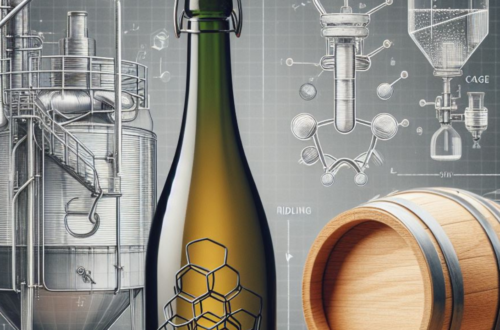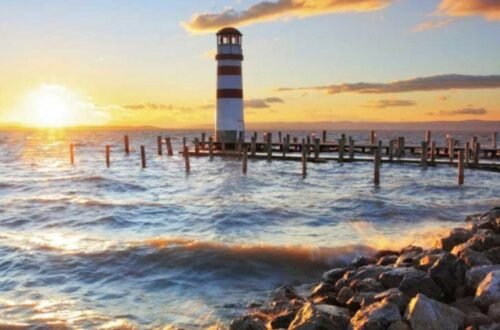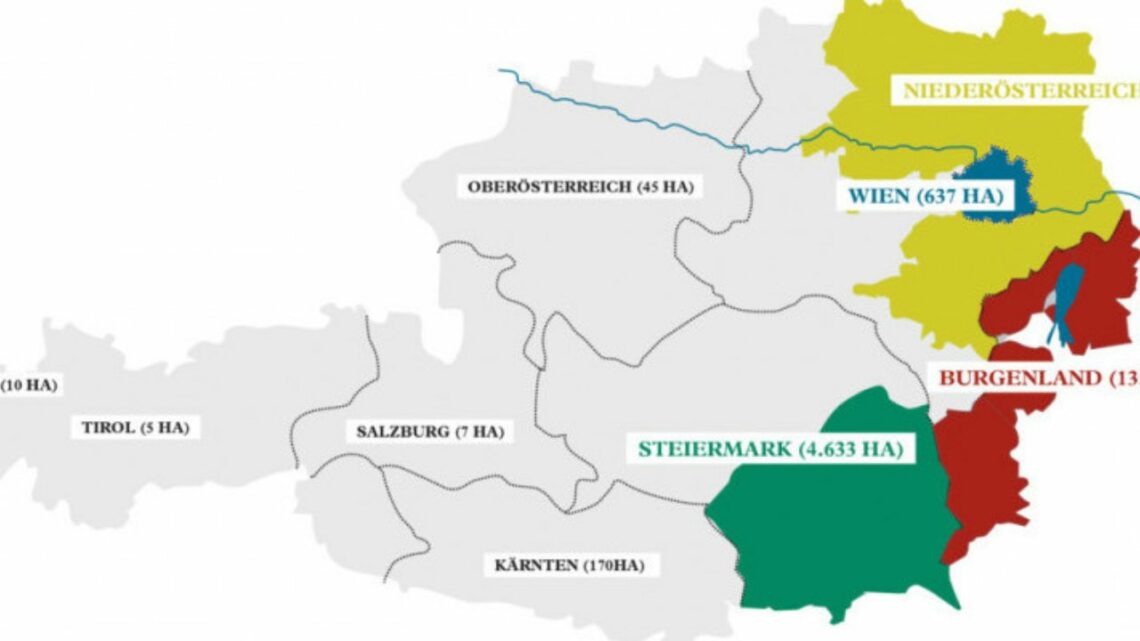
A Quick Guide to Austria’s Top Wine Regions
If you weren’t so good in geography at school, let me come with a key reminder : Austria is nestled in the heart of Europe.
A lot of people are surprised when I remind them that Austria is renowned for its picturesque vineyards, diverse grape varieties, and exceptional winemaking traditions. Indeed, it has a rich and vibrant wine culture that dates back centuries.
Within Austria, there are several notable wine regions that have gained international acclaim for their distinctive wines. From the scenic hills of Wachau (one of my favourite places in the world!) to the sunny slopes of Burgenland, each region showcases its unique terroir and winemaking styles!
Within this quick guide to Austria’s top wine regions, you’ll find the characteristics that make them stand out and present to you why I love those wines so much.
So, join me on this journey and let’s start with an overview of the four main wine areas (and not regions) that Austria has. Indeed, these areas are political entities and were then divided into regions.
An overview of the four wine areas in Austria
There are four main wine areas in Austria. And it’s important to remember that these are political entities. It’s not like in other countries, such as France where a region has its own “wine identity”. Even if we will find some similarities within a wine region (which enabled Austria to create its famous DAC), it was divided as such as first.
First, the largest and perhaps most well-known : Niederösterreich, which literally translates into Lower Austria and lies … in the northeast of the country! Now why is that? Well, it’s because the name “Lower Austria” is not actually a reference to its geographical location (in the north of Austria).
ANECDOTE : The name comes from the historical division of Austria in two parts : Oberösterreich (Upper Austria) and Niederösterreich (Lower Austria). In this context, “Upper” refers to the lands upstream along the Danube River, while “Lower” refers to the lands downstream.
Thus, Niederösterreich is bordered by the Czech Republic and Slovakia to the north and east, respectively.
So, yes, at first sight, the name be a bit confusing in confusing in terms of its geographical location, but it is a reflection of Austria’s historical divisions and the flow of the Danube River.
Niederösterreich is mostly known for its dry whites wines made from Riesling and Grüner Veltliner, a local grape.
It is subdivided into 8 sub regions : Wachau, Kremstal, Kamptal, Traisental, Wagram, Weinviertel, Carnuntum and Thermenregion.
At the east of Austria lies Burgenland. The name means “land of castles” in German and it comes from the fact that the region was once home to many castles and fortresses. It was part of the Kingdom of Hungary until the end of WWI, when it became part of Austria following the collapse of the Austro-Hungarian Empire.
This meant that some winemakers (such as Gamser) had grapes on both sides of the border. The concept of Doppelbesitz was born, meaning the producers were allowed to use the grapes on both sides of the border in 2015. If you want to know more about Austria’s wine history, check out my post on the subject.
Although, Burgenland is the least populated state in Austria, it has a rich history. It used to be inhabited by Celts, Romans and various Germanic tribes over the centuries. Its strategic location has made it a site of numerous conflicts throughout history, including battles between the Ottoman Empire and the Habsburg in the 16th and 17th centuries.
Burgenland is mostly known for its red wines, made from Blaufränkisch and its sweet white wines made from Welschriesling.
It is subdivided into 5 sub regions : Leithaberg, Neusiedlersee, Mittelburgenland, Eisenberg, Rosalia
In the south lies Steiermark, Styria in English, border by Slovenia to the south and Hungary to the east. The name comes from the German word “Steirer” (Styrian) and “Mark” (borderland). It means “borderland of the Styrians”, referring to the fact that the region was historically a frontier area between the Slavic and Germanic peoples.
Today, Styria is known for its scenic landscapes including the Dachstein Mountains and Graz, which has a well-preserved historic center and is a UNESCO World Heritage. It is also a center for innovation and technology, especially in the fields of renewable energy and environmental engineering.
Steiermark is mostly known for its aromatic white wines, made from Sauvignon Blanc and Muskateller.
It is subdivided into 3 regions : Vulkanland, Südsteiermark, Weststeiermark
Last, Vienna of course. Vienna is the only capital in the world to have vines IN the town.
Vienna is famous for its Gemischter Satz. Indeed, in the past, planting a single variety of grapes was considered a risky move by growers. To mitigate this risk, they began blending wines from grapes harvested from different fields.
Typically, the entire vineyard would be harvested at once, resulting in a mix of slightly under ripe, perfectly ripe, and somewhat overripe grapes that would provide a rough but balanced flavor the wine.
Today, Wiener Gemischter Satz is a DAC, and requires a minimum blend of three varieties, with no single variety making up more than half of the final blend.
The most famous wine region : Wachau
Let’s start by the popular kid : the Wachau wine region! So, if you remember through my other posts, wines have a direct connection with soil. In the Wachau, we have weathered granite and gneiss that are frequently fissured, enabling the roots of the vines to penetrated deeply into the earth. This means they can get a max of water and nutrients!
There’s a lot of terraces in the Wachau, upheld by dry stone walls. This means using machines is next to impossible and thus, there’s a lot of manual labor.
It doesn’t rain a lot in the Wachau and soils are highly permeable, which means water scarcity is also a concern.
Due to the topography (ie the hills) and the influence of the Danube, there is a lot of micro climates : the warm air from the Pannonian plains (ie from Hungary) meet the cold air from the Weinviertel (from the North, Slovakia) which results in a wide variation between daytime and nighttime temperatures.
How does this influence the wines? Due to this, the wines tend to be high in acidity and with structured.
Next, wine is due to grapes and winemaking techniques. These winemaking techniques are influenced by regulations that come from the appellation (DAC) and a group of winemakers that decided that Wachau wine should be made in a certain way.
Let’s start with the grapes!
The Grüner Veltliner grape is the most important variety grown in the Wachau, followed by Riesling, Müller-Thurgau Neuburger, Weissburgunder, Gelber Muskateller, Sauvignon Blanc and even Zweigelt.
Riesling is often cultivated on the stoniest gneiss terraces, which are rich in minerals such as quartz and feldspar
The top vineyards (Ried in German or “climat” in France, just like in Burgundy) in the region include Loibenberg, Kellerberg, Klaus, Achleiten, Hichrain and Singerriedel. SO if you’re looking to purchase a wine from the Wachau region, it’s important to check the vineyard where the grapes were grown, usually indicated after the word “Ried” on the label.
Now here comes the regulations.
Recently, the Wachau region was designated as a DAC (Districtus Austriae Controllatus). However, prior to this, the top growers had established the Vinea Wachau Nobilis Districtus, a three-tier system (sort of three levels of quality) that currently has 200 members.
The first tier is Steinfeder, which is named after the local grass and produces wines with an alcohol content ranging from 11% to 11,5%. These wines are intended to be consumed young and have fresh character.
The second tier is Federspiel, which takes its name from a falconry lure and is comparable to a dry Kabinett with a minimum must weight of 17% KMW and an alcohol content of 11,5% to 12,5%.
The highest tier is Smaragd, named after a lizard that inhabits the vineyards during hot spells. These wines have a minimum alcohol content of 12% and can have up to 9 grams of residual sugar.
In terms of winemaking, Vinea Wachau imposes strict rules on its member, prohibiting chaptalization (ie the use of concentrated must or mechanical concentrators, wood chips and tannin additions) as well as alcohol-reducing techniques (like reverse osmosis and spinning cones).
Most producers discourage malolactic fermentation, although partial malolactic fermentation can occur.
In terms of wineries, check out my instragram page where I share most of my tastings or my newsletter, where I share all my tastings and give you a lot of other hints! You’ll also be the first to know when my new posts come out!
In the meantime, some names you may want to look out for : Alzinger, Frischengruber, Holzapfel, Knoll, F.X Pichler, Prager and of course THE cooperative Domäne Wachau, which is a great way to taste how the type of soil can influence a wine.
Second place : Burgenland, home to red and sweet white wines
Let’s start with a bit of history. Indeed, the land of castles has to have a great history!
The Burgenland region has ample archaeological evidence indicating that the Romans produced wines there to supply their settlements in Carnuntum and Vienna. The area around Neusiedlersee became renowned for its sweet wines, particularly Rust for its Ausbruch.
Prior to 1921, this region was part of Austria-Hungary, but after WWI and the Treaty of Versailles, Hungary gained independence. Despite this, the residents voted to remain in Austria, and the area was renamed Burgenland.
Initially, its wines were not well-known, and the primary grapes grown were Hungarian varieties. These wines were mostly exported to Slovakia, Hungary, and Poland. The principal grape varieties of Burgenland were also found in the Sopron village of Hungary. Over time, however, these grapes went into decline, and more “Austrian” varieties, such as Welschriesling, became prevalent.
Burgenland initially stagnated, and after 1945, it was under Russian occupation. However, after the Russians withdrew in 1956, there was a renewed interest in the region, and its reputation grew as a source of inexpensive sweet wines until the scandal of 1985.
Which grapes are used?
Blaufränkisch represents 22% of the plantings, followed by Zweigelt at 19%, Grüner Veltliner at 10%, Welschriesling at 10%, and Chardonnay and Weissburgunder at roughly 5% each.
A quick word on the regulations
When the DAC system appeared, first in Lower Austria, it led to regional changes in Burgenland, which is now divided into five separate regions: Leithaberg, Neusiedlersee, Mittelburgenland, Eisenberg, and Rosalia. Rosalia, created in 2018, is essentially the southwest extension of the Leithaberg.
Now, what about the wines?
There is a wide variety of wine styles available in Burgenland. Outstanding sweet wines are still produced around the lake, with red wines being produced further from the lake. In particular, the slopes of Leithaberg and hills of Eisenberg and Mittelburgenland provide excellent conditions for red wines, with limestone and clay soils, as well as some schist, which have good water retention and drainage.
ANECDOTE : However, Alois Kracher, a famous winemaker who did a lot for Austrian wines, stated in 2003 that there are no Austrian reds that can compete with the best of Bordeaux or Napa at ten years old. Austria has its own grapes, but it does not have its own style, resulting in a conflict between regionality and international acceptance. It will take Austria a while to be recognized internationally, as there is fierce competition from other countries that are also improving quality quickly. There is no single strategy for red wine production, with some producers preferring international varieties, while others focus on Austrian ones.
Third place : Styria, home to aromatic white wines
A quick word on Styria’s history
The region of Steiermark has 4630 hectares of vineyards, which are characterized by their steep slopes and located mostly in the southern parts. The area has a rich history of viticulture, dating back to the Celts and Romans, with subsequent contributions from monasteries.
However, wars and plagues in the 16th and 17th centuries caused a decline in the industry. In the 1840s, Archduke Johann, banished to Styria due to his controversial marriage and political activities, revived viticulture by establishing a research institute in the region, based in Maribord (now in Slovenia).
The climate in Styria
Despite its challenging climate, with temperatures dropping as low as -20 degrees Celsius and high levels of precipitation, Styria produces some of Austria’s most refreshing white wines. The smallest region, Südsteiermark, has the largest surface area of vineyards.
The grapes in Styrian wines
The most prominent grape varieties in Steiermark are white wines such as Sauvignon Blanc, Chardonnay (or Morillon), Weissburgunder, Grauburgunder, Gelber Muskateller, and Traminer. Styrian winemakers take a more subtle approach to oak aging, resulting in invigorating and nuanced wines.
Winemaking in Styria
Styrian winemakers are proud of their traditions, and some, like the Gross estate, have revived the use of Stettin barrels made from Styrian oak, which have a unique capacity of 565 liters. The Stettin barrels were originally designed to hold must from 10 Eimer (buckets of grapes) brought in by harvesters. Another feature of these barrels is that their staves are thick and lightly toasted.
Last but not least : Regulations
The “Schmecke das Leben” group of natural-wine producers includes Strohmeier, Tauss, Wertlitsch, Andreas Tscheppe, and Sepp Muster.
Additionally, growers associations like STK (Steirische Terroir- und Klassikweingüter) have their own hierarchy of Erste Lage and Grosse Lage, similar to the Traditionsweingüter of Lower Austria. The members of this association are Gross, Lackner-Tinnacher, Neumeister, Polz, Sattlerho, Tehment, Frauwallner, Wohlmuth, Hannes Sabathi, Erwin Sabathi, Maitz, and Winkler Hermaden.
The region’s DAC was established in 2018 and includes a three-tier system for regional, village, and single-vineyard wines. Hand-harvesting is mandatory, and all grape varieties are included in the system.
Fourth place: Kamptal, home to mineral-rich Grüner Veltliner
Soil and climate in Kamptal
Kamptal, names after the river Kamp, is a region with 3907ha of vineyards. The soil in this region is diverse, ranging from loess found in Wagram to the east, to primary rock and conglomerates in higher areas, and more loess and loam in lower areas closer to the Danube.
The primary rock soil produces powerful Riesling wines, while Grüner Veltliner thrives on loess and loam. Among the vineyards, the most renowned is Zöbinger Heiligenstein, which has a total area of 70ha and is situated 300m high facing south and west.
Its soils is made up of weathered sandstone with volcanic conglomerates (perm) and fractured sandstone, which allows vine roots to penetrate in search of nutrients. This is the ONLY place in Austria where Riesling grows on perm soil.
The micro climate is warm, resulting in grapes with high sugar levels, and Heiligenstein Rieslings are known for their striking minerality and long life.
The regulations
The DAC classification in Kamptal allows only Grüner Veltliner and Riesling. The Klassik cuvée must have a minimum of 12% alcohol and show no oak influence, typically vinified and aged in steel tanks. The Reserve cuvées require a minimum of 13% alcohol and may have some botrytis or wood tones.
In terms of wineries, the area surrounding Langenlois is gaining recognition in Austria for its high-quality sparkling wines produces by Bründlmayer, Schloss Gobelsburg, Loimer, Jurtschitsch and Steininger.
Conclusion : What are the most famous wine regions in Austria?
The Austrian wine regions are renowned for their distinct characteristics and exceptional wines. Among these regions, Wachau holds a prominent place as one of the most famous wine regions in Austria.
While Wachau stands out as a renowned wine region, let’s not forget the other ones.
Burgenland, known for its red and sweet white wines, boasts a rich history and distinct terroir.
Styria, with its steep slopes, challenging climate, and aromatic white wines, also makes a significant contribution to Austria’s wine production.
Kamptal, famous for its mineral-rich Grüner Veltliner and Riesling, and its recognition for high-quality sparkling wines in the area surrounding Langenlois, complete the list of Austria’s most famous wine regions.
So start clicking and check out your favourite wine region!





